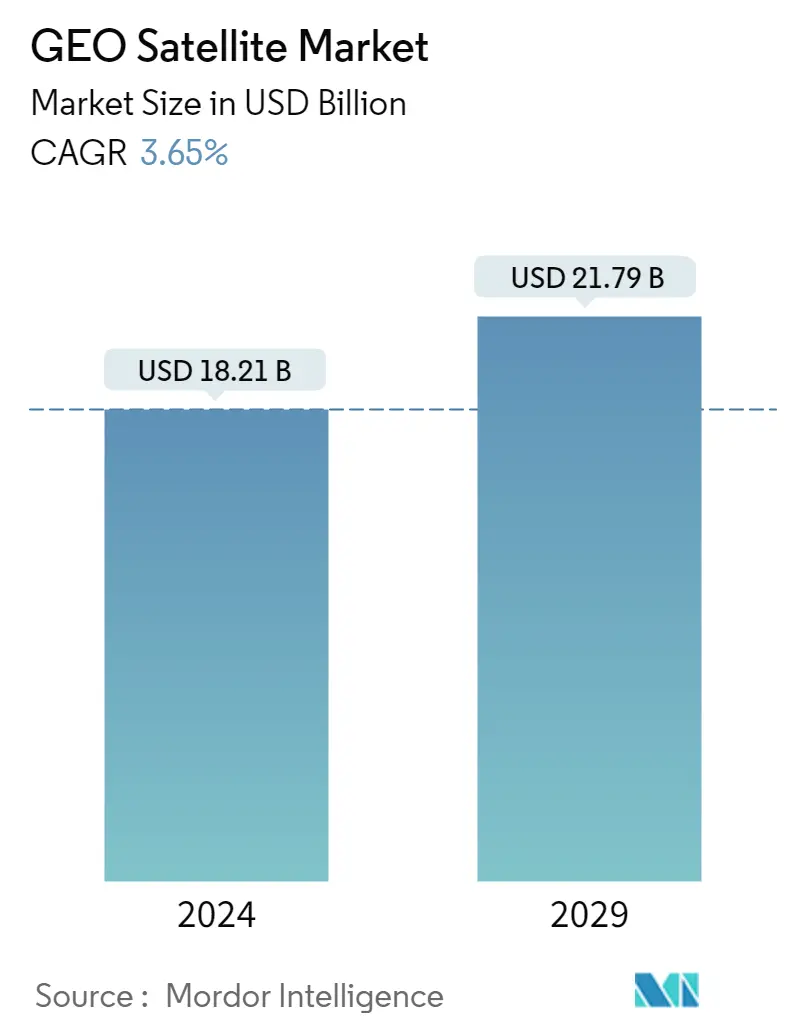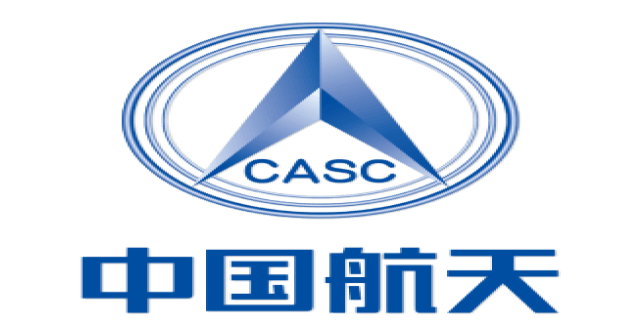Market Size of geo satellite Industry

|
|
Study Period | 2017 - 2029 |
|
|
Market Size (2024) | USD 18.21 Billion |
|
|
Market Size (2029) | USD 21.79 Billion |
|
|
Largest Share by Propulsion Tech | Liquid Fuel |
|
|
CAGR (2024 - 2029) | 3.65 % |
|
|
Largest Share by Region | Asia-Pacific |
Major Players |
||

|
||
|
*Disclaimer: Major Players sorted in no particular order |
GEO Satellite Market Analysis
The GEO Satellite Market size is estimated at USD 18.21 billion in 2024, and is expected to reach USD 21.79 billion by 2029, growing at a CAGR of 3.65% during the forecast period (2024-2029).
18.21 Billion
Market Size in 2024 (USD)
21.79 Billion
Market Size in 2029 (USD)
-19.61 %
CAGR (2017-2023)
3.65 %
CAGR (2024-2029)
Largest Market by Propulsion Tech
73.93 %
value share, Liquid Fuel, 2022
Due to its high efficiency, controllability, reliability, and long lifespan, liquid fuel-based propulsion technology is an ideal choice for space missions. It can be used in various orbit classes for satellites.
Largest Market by Application
47.82 %
value share, Communication, 2022
Governments, space agencies, defense agencies, private defense contractors, and private space industry players are emphasizing the enhancement of the communication network capabilities for various public and military reconnaissance applications.
Largest Market by Satellite Subsystem
NaN %
value share, Structures, Harness & Mechanisms, Harness & Mechanisms
The demand for these propulsion systems is driven by the launch of mass satellite constellations into space. They are used for transferring the spacecraft to the orbit.
Largest Market by region
64.23 %
value share, Asia-Pacific, 2022
Government collaborations with private players are emphasizing the growth of GEO Satellite in the Asia-Pacific region. In addition, continuous investments towards the development of these satellites by China and India is also prompting to the increased growth.
Leading Market Player
47.98 %
market share, China Aerospace Science and Technology Corporation (CASC), 2022

China Aerospace Science and Technology Corporation is the largest player in the global GEO satellites market. CASC offers a wide range of launch vehicles and adopts a competitive pricing strategy to attract customers globally.
Liquid fuel propulsion is expected to surge during the forecast period
- A satellite's propulsion system plays a key role in changing its speed and direction. It is also used to adjust the position of the spacecraft in orbit. After entering orbit, the spacecraft requires attitude control to correct its orientation with respect to the Earth and the Sun. In some cases, it is necessary to move the satellite out of orbit, and without the ability to adapt to orbit, the satellite is considered dead. Therefore, the importance of powertrain systems is expected to drive market growth. Different types of fuel are used for different purposes. Liquid propellants use rocket engines that use liquid propellants. Gas fuels can also be used but are less popular due to their low density and difficulty using conventional pumping methods. In 2020, the market was declined by 44%, impacted by the manufacturing and operational challenges faced by the pandemic.
- The liquid system that made it possible has proven to be highly efficient and reliable. These include hydrazine systems, single or dual propulsion systems, hybrid systems, cold/hot air systems, and solid propellants. It is used when strong thrust or quick maneuvering is required. Therefore, liquid systems will continue to be the space propulsion technology of choice if their total thrust capacity is sufficient to meet mission requirements.
- On the other hand, electric propulsion is commonly used to hold stations for commercial communications satellites, and its high specific impulse makes it the primary propulsion for some space exploration missions. The utilization of electric propulsion systems is expected to surge during 2023-2029, and the overall market is expected to surge by 22%. New satellite launches are expected to accelerate market growth during the forecast period.
Liquid fuel propulsion is expected to surge during the forecast period
- The global GEO satellite market is expected to grow significantly in the coming years, driven by various satellite applications across different industries. The market can be analyzed concerning North America, Europe, and Asia-Pacific, which are the major regions in terms of market share and revenue generation. Between 2017 and 2022, 147 satellites were manufactured and launched by various operators in this segment into GEO. Of these 147 satellites, nearly 75% were launched for communication purposes.
- North America is expected to dominate the global GEO satellite market due to the presence of several leading market players, such as Boeing, Lockheed Martin, and Northrop Grumman. The increasing demand for high-speed internet, navigation services, and remote sensing applications in the region is expected to fuel market growth. Between 2017 and 2022, the region accounted for 30% of the total satellites manufactured and launched into GEO.
- In Europe, the GEO satellite market is expected to grow significantly due to the increasing demand for high-speed internet and communication services. The ESA has been investing heavily in the development of advanced satellite technology, which is expected to further drive the growth of the market in the region. During 2017-2022, the region accounted for 11% of the total satellites manufactured and launched into GEO.
- In Asia-Pacific, increasing investments in the development of satellite technology and infrastructure by governments and private organizations in the region are expected to further boost the growth of the market. During 2017-2022, the region accounted for 59% of the total satellites manufactured and launched into GEO.
GEO Satellite Industry Segmentation
Communication, Earth Observation, Navigation, Space Observation, Others are covered as segments by Application. 10-100kg, 100-500kg, 500-1000kg, above 1000kg are covered as segments by Satellite Mass. Commercial, Military & Government are covered as segments by End User. Electric, Gas based, Liquid Fuel are covered as segments by Propulsion Tech. Asia-Pacific, Europe, North America are covered as segments by Region.
- A satellite's propulsion system plays a key role in changing its speed and direction. It is also used to adjust the position of the spacecraft in orbit. After entering orbit, the spacecraft requires attitude control to correct its orientation with respect to the Earth and the Sun. In some cases, it is necessary to move the satellite out of orbit, and without the ability to adapt to orbit, the satellite is considered dead. Therefore, the importance of powertrain systems is expected to drive market growth. Different types of fuel are used for different purposes. Liquid propellants use rocket engines that use liquid propellants. Gas fuels can also be used but are less popular due to their low density and difficulty using conventional pumping methods. In 2020, the market was declined by 44%, impacted by the manufacturing and operational challenges faced by the pandemic.
- The liquid system that made it possible has proven to be highly efficient and reliable. These include hydrazine systems, single or dual propulsion systems, hybrid systems, cold/hot air systems, and solid propellants. It is used when strong thrust or quick maneuvering is required. Therefore, liquid systems will continue to be the space propulsion technology of choice if their total thrust capacity is sufficient to meet mission requirements.
- On the other hand, electric propulsion is commonly used to hold stations for commercial communications satellites, and its high specific impulse makes it the primary propulsion for some space exploration missions. The utilization of electric propulsion systems is expected to surge during 2023-2029, and the overall market is expected to surge by 22%. New satellite launches are expected to accelerate market growth during the forecast period.
| Application | |
| Communication | |
| Earth Observation | |
| Navigation | |
| Space Observation | |
| Others |
| Satellite Mass | |
| 10-100kg | |
| 100-500kg | |
| 500-1000kg | |
| above 1000kg |
| End User | |
| Commercial | |
| Military & Government | |
| Other |
| Propulsion Tech | |
| Electric | |
| Gas based | |
| Liquid Fuel |
| Region | |
| Asia-Pacific | |
| Europe | |
| North America | |
| Rest of World |
GEO Satellite Market Size Summary
The GEO Satellite Market is poised for significant growth, driven by the increasing demand for satellite applications across various industries. The market is characterized by the critical role of propulsion systems in satellite operations, including speed and direction adjustments, orbit positioning, and attitude control. The use of liquid and electric propulsion systems is expected to surge, with liquid systems remaining the preferred choice for their efficiency and reliability. The market's expansion is further supported by new satellite launches and advancements in satellite technology, such as high-throughput satellites (HTS) that enhance data capacity and communication speeds. The market is fairly consolidated, with major players like Airbus SE, China Aerospace Science and Technology Corporation, Lockheed Martin Corporation, Maxar Technologies Inc., and Thales dominating the landscape.
Regionally, North America is anticipated to lead the market due to the presence of key industry players and the growing demand for high-speed internet, navigation, and remote sensing services. Europe is expected to experience significant growth, fueled by investments from the European Space Agency in advanced satellite technology. In the Asia-Pacific region, increasing investments in satellite technology and infrastructure by governments and private organizations are set to boost market growth. The region has seen substantial satellite launches, with countries like China, India, and Japan leading in space capacity and infrastructure. The market's growth trajectory is supported by the rising number of military satellites and the expanding applications of GEO satellites in communications, navigation, surveillance, and other services.
GEO Satellite Market Size - Table of Contents
-
1. MARKET SEGMENTATION (includes market size in Value in USD, Forecasts up to 2029 and analysis of growth prospects)
-
1.1 Application
-
1.1.1 Communication
-
1.1.2 Earth Observation
-
1.1.3 Navigation
-
1.1.4 Space Observation
-
1.1.5 Others
-
-
1.2 Satellite Mass
-
1.2.1 10-100kg
-
1.2.2 100-500kg
-
1.2.3 500-1000kg
-
1.2.4 above 1000kg
-
-
1.3 End User
-
1.3.1 Commercial
-
1.3.2 Military & Government
-
1.3.3 Other
-
-
1.4 Propulsion Tech
-
1.4.1 Electric
-
1.4.2 Gas based
-
1.4.3 Liquid Fuel
-
-
1.5 Region
-
1.5.1 Asia-Pacific
-
1.5.2 Europe
-
1.5.3 North America
-
1.5.4 Rest of World
-
-
GEO Satellite Market Size FAQs
How big is the GEO Satellite Market?
The GEO Satellite Market size is expected to reach USD 18.21 billion in 2024 and grow at a CAGR of 3.65% to reach USD 21.79 billion by 2029.
What is the current GEO Satellite Market size?
In 2024, the GEO Satellite Market size is expected to reach USD 18.21 billion.

